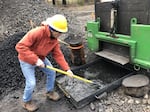
A forestry worker dredges out cooling bits of biochar released by the CharBoss outside Vida, Ore., March 7, 2023.
Brian Bull/KLCC / AP
Roughly two years after the devastating blaze, recovery efforts from the Holiday Farm Fire continue in the McKenzie River Corridor.
One tool does a fresh take on the “lemons to lemonade” proverb, by taking one by-product of salvage efforts and converting it into something useful.
Outside Vida in an affected area, a worker uses a chainsaw to cut up an immense log held by a small tractor. The whole hillside behind him is dotted with burnt stumps and downed timber, commonly called slash.
Salvage efforts since fall of 2020 have found many trees that have suffered extensive damage, enough that many aren’t usable for much. But leaving these around — along with other debris — creates fuel for future wildfires.
But nearby, workers are also operating an open metal chamber that’s taking all that slash, and incinerating it.
Jonas Parker, a district hydrologist and soil scientist with the Bureau of Land Management, explained to KLCC how the air current burner — in this case, a CharBoss — works.
“Oxygen is brought in through the motor that you hear running,” said Parker, pointing to a long, green and black contraption. “It surrounds the fire in a curtain of forced air. That makes the fire burn incredibly hot and incredibly efficient, and coats all of the burning material in a layer of ash.”
The CharBoss then expels the smoldering, condensed matter — called biochar — out the back via a metal conveyer belt. It falls into a broad tray of water (called a quench pan), which lets it cool off some. Another worker dredges the material, and sorts it into a pile of biochar. It’s eventually used to help improve soil quality and water retention.
Conservationists and forest officials have commented how the Holiday Farm Fire got so hot in areas, that it essentially sterilized the soil. Erosion is another problem caused by loss of foliage, which in turn can cause runoff and during the winter months, mudslides and rockslides.
Through integrating biochar into the affected areas, the soil can be enriched and also made less apt to let water flow away. And the CharBoss contains a lot of the burning matter within its chamber, which means less smoke released into the air.
The Holiday Farm Fire erupted over the Labor Day Holiday in 2020, and decimated many areas including Blue River and parts of Vida, Rainbow, and the Delta Campgrounds. It burned nearly 174,000 acres. One death is attributed to the fire.